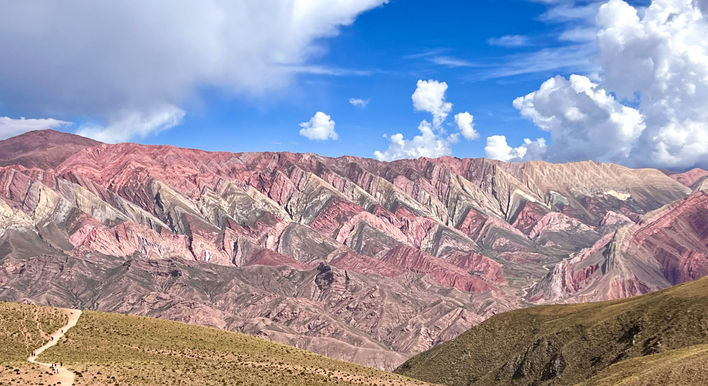When you’re visiting Argentina with Poncho Tours, you will notice many roadside shrines: one featuring red flags, another mountains of plastic bottles. You may also be sharp-eyed enough to spot small altars festooned with black flags.
These are three of the (un)holy trinity (one of those again) of popular saints, part of Argentina’s rich tapestry of folk traditions.
A tour we think you'll love
The red flags mark shrines to Gauchito Gil, a hero of the war of the Triple Alliance (when Argentina, Uruguay and Brazil all ganged up against Paraguay) between 1864 and 1870, who then fell out with the wrong caudillo.
Legend has it that on returning home to Corrientes after the war, the local strong man tried to draft him into his band of unmerry men.
He refused to be press-ganged, and was sentenced to death by firing squad. Just before the triggers were pulled, Gil cursed the warlord, telling him when he returned home he would find his baby son close to death: the only cure for his mysterious malady would be to pray for his forgiveness. And so it came to pass, the baby survived, and a legend was born.
Whether Gauchito Gil’s final moments are accurate or not, what really happened is less relevant than the fact that this spawned a cult of the heroic gaucho which is stronger than ever 150 years after his death.
The red flags echo the scarf of Gauchito Gil, which he is always depicted wearing along with a light blue shirt: my own interpretation is that these colours, respectively of the Federalist and Unitarian forces from the Civil War, show a nation trying to heal after spending most of the 19th century in conflict.
Gauchito Gil is also depicted on a cross, turning him into a Christ-like martyr, and his followers leave offerings of coca leaves, traditional in pre-Christian traditions, so all three beliefs are synthesised in his figure. Here on our blog you can read more about the holy coca leaf.
A similar post-Independence saint is Difunta Correa (literally Deceased Correa): Deolinda Correa’s husband was taken off to fight in the Civil Wars on the side of the La Rioja caudillo Juan Bustos.
Pregnant at the time, and not knowing when her husband might return, on giving birth she set out on foot to try and find the army.
At a place called Vallecito, in San Juan province, on the border with La Rioja, she ran out of food and water and lay down to die, but passing travellers found her baby alive, still suckling from her breast.
The Difunta Correa story may have roots in pre-hispanic culture, referencing a legend of the indigenous Huarpe tribe who populated this part of NW Argentina before the Spanish invaded.
A woman died after being caught in a snowstorm in the Andes, but her husband saved their baby’s life by pressing the child to his breast, from which milk miraculously spouted.
As with Gauchito Gil’s Christ-like qualities, the depiction of Deolinda Correa clutching her baby to her breast echo images of the Virgin Mary and Jesus. Among the offerings, followers leave bottles of water (never empty), as she died of hunger and thirst.
The third figure whose black flag-decorated shrines are often found close to those of Gauchito Gil (because he was a devotee himself) is San La Muerte: a chilling skeletal figure in a black hooded cloak, loosely connected with gang culture in Argentina and beyond.
Though decidedly NOT a Catholic saint, San La Muerte (Saint Death) was actually a Jesuit priest from Misiones (on the border with Paraguay, where he is equally popular, and close to Gauchito Gil’s home province of Corrientes).
Like many Jesuits, he was concerned with the spiritual welfare and education of the indigenous people, but the Church hierarchy felt he’d gone native and was showing too much concern for their human rights as well, so they banned him from continuing his mission.
He went on hunger strike in protest, and one day was found dead, his skeletal figure still in a standing position.
Today, followers have his image tattooed on their bodies, or even sewn into their skin for protection from their enemies.
There’s a shrine to Gauchito Gil and San La Muerte on the old road from Salta to San Salvador de Jujuy which we always follow on our tours to the Quebrada de Humahuaca, home to the famous Seven Coloured hill of Purmamarca, and gateway to the Salinas Grandes salt flats.
This also features the female Santa Muerte, a skeletal figure popular in Mexico clad in a white wedding dress, but that’s a story for another blog…






